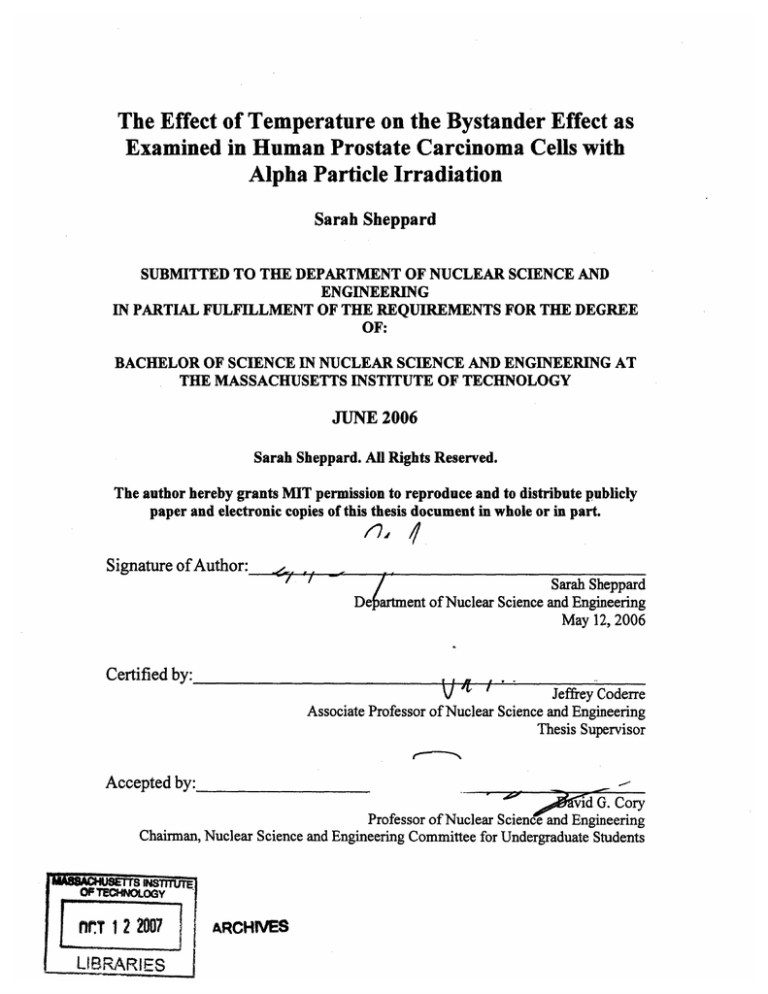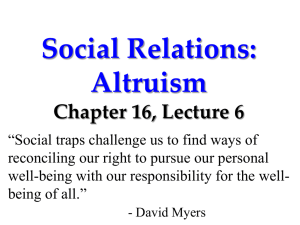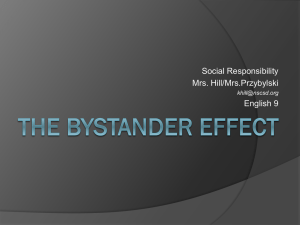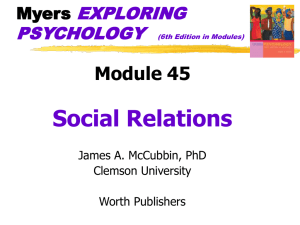
The Effect of Temperature on the Bystander Effect as
Examined in Human Prostate Carcinoma Cells with
Alpha Particle Irradiation
Sarah Sheppard
SUBMITTED TO THE DEPARTMENT OF NUCLEAR SCIENCE AND
ENGINEERING
IN PARTIAL FULFILLMENT OF THE REQUIREMENTS FOR THE DEGREE
OF:
BACHELOR OF SCIENCE IN NUCLEAR SCIENCE AND ENGINEERING AT
THE MASSACHUSETTS INSTITUTE OF TECHNOLOGY
JUNE 2006
Sarah Sheppard. All Rights Reserved.
The author hereby grants MIT permission to reproduce and to distribute publicly
paper and electronic copies of this thesis document in whole or in part.
Signature of Author:
~I~I·
-'
--
/
Sarah Sheppard
De artment of Nuclear Science and Engineering
May 12, 2006
Certified by:
V
/
Jeffrey Coderre
Associate Professor of Nuclear Science and Engineering
Thesis Supervisor
A . . . . .
Icc
t _.
epted by:
id G. Cory
Professor of Nuclear Science and Engineering
Chairman, Nuclear Science and Engineering Committee for Undergraduate Students
INSTMAUE
OF TECHNOLOGY
2007
nrT RS2
LIBRARIES
ARCHNVES
Sheppard and Coderre
The Effect of Temperature on the Bystander Effect as
Examined in Human Prostate Carcinoma Cells with
Alpha Particle Irradiation
Sarah Sheppard
Submitted to the Department of Nuclear Science and Engineering on May 12, 2006
in partial fulfillment of the requirements for the degree of Bachelor of Science in
Nuclear Science and Engineering at the Massachusetts Institute of Technology
Abstract
The bystander effect is seen when irradiated cells release a factor that can produce
damage or death in neighboring "bystander" cells that are not actually hit by any
radiation. One proposed mechanism involves the irradiated cells releasing a soluble factor
into the medium that can cause damage to the non-irradiated cells. Previous studies in the
Coderre lab showed that the soluble factor released by DU-145 human prostate
carcinoma cells was a short-lived, free radical species (Wang and Coderre, Rad. Res.,
164, 711-722, 2005). This thesis examined the effect of temperature on the bystander
effect. A co-culture system was used to create irradiated and bystander DU-145 cells in
the same medium. This thesis showed that a decrease in temperature lessens or prevents
the bystander effect. Researching the bystander effect will allow a better understanding of
a process that may already be occurring during alpha-particle based therapies such as
boron neutron capture therapy (BNCT) and tumor radioimmunotherapy and could
provide a means to improve these therapies.
Sheppard and Coderre
Introduction
Prostate Cancer
Prostate cancer is the most common form of cancer among males in Western countries. In
2006 in the United States, 235,000 new cases are estimated to be diagnosed and 30,000
men will die from prostate cancer. See Jemal et al [1] for other cancer statistics.
The prostate is a walnut-sized gland between the bladder and the penis, in front of the
rectum, that produces seminal fluid. Small, primary (original) tumors within the prostate
are formed in the early stages of prostate cancer. Secondary tumors are formed when the
original cancer metastasizes or spreads to other parts of the body. External beam
radiotherapy, surgery (radical prostatectomy), brachytherapy and hormone therapy
(androgen deprivation therapy) are common treatments used in the early stages of
prostate cancer with a 90% cure rate, discussed in [2-4]. Unfortunately, there are no or
few symptoms of cancer at this early stage. The new use of prostate-specific antigen
(PSA) testing allows physicians to detect tumors in the prostate before they metastasize
[5, 6].
About 30,000-40,000 prostate cancer patients per year have metastatic prostate cancer.
Once the cancer metastasizes, treatment options are less effective and a significant
decrease is seen in cure rates. In about 80% of these cases, the cancer metastasizes to
bone. Hormone therapy is initially effective, but the majority of cases develop a
resistance. Chemotherapy generally does not work due to systemic toxicity [7]. For
Sheppard and Coderre
palliative
relief
of
pain,
bone-seeking
radiopharmaceuticals
are
used.
Radioimmunotherapy, the attachment of radioisotopes to tumor specific monoclonal
antibodies, is an experimental treatment for leukemia and metastatic solid tumors,
including prostate [8, 9].
Prostate cancer is a good candidate for radioimmunotherapy for multiple reasons.
Prostate specific antigens allow a selective targeting of monoclonal antibodies. This is
more effective, because each tumor may or may not express the same antigen. When
prostate cancer metastasizes, it usually travels to the bone marrow or the lymph nodes.
Metastases in these locations are more accessible to the circulating radiolabeled
monoclonal antibodies. Often these new tumors are small which allows the antibodies to
completely penetrate the metastases and effectively deliver the radiation to all tumor
cells. Finally, PSA testing allows physicians to assess the effectiveness of the treatment.
[10]
The Bystander Effect
The bystander effect is seen when irradiated cells release a factor that can produce
damage or death in neighboring "bystander" cells that are not actually hit by any
radiation. Researching the bystander effect will allow a better understanding of a process
that may already be occurring during tumor radioimmunotherapy.
The bystander effect was first identified by Nagasawa and Little in 1992 [11]. According
to their research, when 1% of Chinese Hamster Ovary (CHO cells were traversed by an
alpha particle (0.31 mGy), over 30% of cells showed DNA damage in the form of a sister
Sheppard and Coderre
5
chromatid exchange. When the same experiment was repeated with x-rays, a dose of 2
Gy was needed to produce the same effect. Confirmation of the bystander effect occurred
4 years later, when Deshpande et al [12] saw the effect using normal human lung
fibroblasts and the same sister chromatid exchange endpoint. Micronucleus formation, a
severe form of DNA damage due to chromosomal fragmentation, and apoptosis, a type of
programmed cell death, are used as endpoints to assess the bystander effect with alpha
particle irradiation [13-16]. Other researchers [17-19] demonstrate that the bystander
effect can differ considerably depending primarily on cell type and the endpoint
examined. Two mechanisms have been suggested for the bystander effect. One
mechanism suggests that gap junctions are utilized for intercellular communication,
requiring cell-to-cell contact, as discussed in [17-21]. The other mechanism, discussed in
[16, 22-25] involves the irradiated cells releasing a soluble factor into the medium that
can cause damage to the non-irradiated cells, assuming they are in the same medium.
These studies [10-24] used normal cells or tissues; however, a few studies have been
conducted using tumor cells. One such study [26] showed that human salivary gland
tumor cells released nitric oxide into the medium after heavy ion irradiation, and the
medium could inhibit cell growth and increase micronucleus formation in un-irradiated
tumor cells. Wang and Coderre [27] performed a study using a co-culture system,
showing that the bystander cells need to be present in the medium during the irradiation
of the target cells and proposing that a short-lived radical species is involved.
Understanding the bystander effect may contribute to improving the effectiveness of
radiation therapy treatments for metastatic prostate cancer. Currently, alpha particles are
Sheppard and Coderre
used in boron neutron capture therapy (BNCT) and radioimunnotherapy. In BNCT, a
high concentration of 'oB (boron-10) is delivered to a tumor relative to the surrounding
healthy tissue. The tissue is then irradiated with thermal or epithermal neutrons. These
neutrons become thermalized in the tissue. 10B will capture a neutron and then the new
11B particle will decay, releasing high linear energy transfer (LET) radiation according to
the equation: 1oB + 'n 4
IB
-
7Li
+ 4He +2.79 MeV. (An alpha particle is a doubly
charged helium ion.) These particles have a short range in tissue (5-9 um). Due to uneven
'lB concentrations and the short-range radiation, the tumor is usually subject to uneven
irradiation. Radioimmunotherapy is the process in which radionuclides are delivered to
the tumor site via tumor-specific monoclonal antibodies. Radioimmunotherapy is most
effective against blood-borne tumors because the tumor antibody is not obstructed from
the tumor [28]. Radioimmunotherapy may be very useful in micrometastatic disease
because it is a systemic treatment, capable, in theory, of seeking out and destroying
tumors too small to be detected by existing imaging technologies. Radioimmunotherapy
does not work as well in solid tumors, because of non-uniform binding of the monoclonal
antibody to the tumor [29]. Solid tumors may also be too big for complete penetration by
the antibody [30, 31]. In BNCT and radioimmunotherapy, alpha particles may not hit all
the tumor cells, thus creating bystander cells. Prostate cancer specifically does not
respond well to traditional chemotherapy, so the effectiveness of radioimmunotherapy
against prostate cancer is being assessed [7-9, 32-35]. The bystander effect, if it exists, is
already present in these alpha-particle therapies, so understanding the bystander effect
could allow it to be manipulated to increase the kill rate among tumor cells.
Sheppard and Coderre
Wang and Coderre developed a co-culture system to test the presence of a soluble factor
in medium creating a bystander effect [27]. This co-culture system allowed the target
cells and bystander cells to be grown separately. The bystander cells were grown on an
insert that was placed in the same media as the target cells before irradiation.
Micronucleus formation was used as an endpoint to assess damage. Wang and Coderre
showed the bystander effect is present in DU-145 cells after alpha particle irradiation.
Medium irradiation and medium transfer experiments were conducted as well. Medium
was irradiated and then added to the cells in the insert and incubated. No bystander effect
was seen. Next, the medium was irradiated with the target cells present, the media was
then removed, filtered, and added to the cells on the insert and incubated. Again, no
bystander effect was observed. These two experiments indicate that the bystander effect,
as seen under these conditions, is not purely a chemical effect. Experiments were also
conducted with radical scavengers DMSO and PTIO to help identify the soluble factor
responsible for the bystander effect. The results from these studies indicated that the
soluble factor is a free radical other than nitric oxide. [27]
The Effect of Temperature on Enzyme Activity
Enzymes are catalysts, usually proteins, that bind to the reactant and speed up the
reaction by lowering the activation energy or energy needed for the reaction to go
forward). There is an ideal pH and temperature for each enzyme to work. Most enzymes
work best at 37 oC or body temperature. As temperature increases, the kinetic energy of
the molecules increases, thus more effective collisions occur and fewer molecules are
needed for the same reaction rate. Simply, as temperature increases to a certain limit,
enzyme activity increases. Each enzyme will have optimum activity in a certain
Sheppard and Coderre
temperature range. Outside this range, the difference in temperature is enough to alter the
structure of the enzyme. The temperature change provides enough energy to break the
intramolecular attractions, such as hydrogen bonding or dipole-dipole interactions, or
hydrophobic forces between non-polar groups in the protein. These changes cause a
change in the secondary structure, 3D conformation of protein chains, and tertiary
structure, interactions between the side chains of a protein. Often this conformational
change can alter the active site, so it can no longer catalyze the substrate molecules it was
supposed to catalyze. [36]
Specific Goals of this Research
This thesis was aimed at determining whether the short-lived radical species proposed by
Wang and Coderre [27] is the result of a chemical or biological effect. Wang and
Coderre's medium irradiation experiments indicated that this effect is not solely a
chemical effect. This research studied the alpha-particle bystander effect on nonirradiated prostate tumor cells by examining the effect of temperature during irradiation
and incubation to further determine whether the effect is chemical or biological. If the
effect is biological, or based on an enzyme, there would be more of an effect at 37 oC and
little or no effect at 4 OC. If the alpha bystander effect is due uniquely to a chemical
effect, i.e. Ca +2 releases from damaged mitochondria, there should be no change in
damage as temperature is varied. Chromosomal damage in the bystander cells was
assessed at these different endpoints and compared to determine if temperature affected
the bystander effect, and whether this effect is chemical or biological.
Sheppard and Coderre
Materials and Methods
Wang and Coderre [27] developed a system, shown in figure 1, to examine the bystander
effect due to a soluble factor using alpha particle irradiation. This system allows cells to
be irradiated with alpha particles while maintaining bystander cells in close proximity (4
mm) in the same media, but beyond the range of the alpha particles. The cells to be
irradiated are seeded on 1.4 um Mylar film in a custom cell dish and the bystander cells
on a Snapwell insert. After 24 hours, the media is changed and the insert is placed upside
down in the media of the Mylar dish. The cells on the Mylar are irradiated from below
with different doses of alpha particles at either room temperature or 4 oC using an
Americium-241 source. After the irradiation, the Mylar dish with the insert is incubated
at 4 or 37 OC for 2 hours. Irradiation at room temperature and incubation at 37 OC were
the control conditions. The insert was then removed from the Mylar dish. Bystander cells
were then harvested and a micronucleus assay was conducted. Chromosomal damage was
assessed by comparing the percentage of binucleated cells containing micronuclei,
counted under 400x magnification on a fluorescent microscope, in the non-irradiated and
experimental samples.
Sheppard and Coderre
cells in the insert serve as
bystander signal receptors
directly irradiated cells
alpha
source
tI /
1
Figure 1. Schematic view of the co-culture system for the bystander effect study. The
bystander cells were 4 mm above the directly irradiated cells. Source: Wang.
Cell Culture
The DU-145 human prostate carcinoma cell line was ordered from American Type
Culture Collection (passage number 57). After their arrival, the cells were cultured for
three passages then frozen in cryovials (- 107 cells per vial) and stored in liquid nitrogen
by Wang [27]. These cells were defrosted and used for 11 passages in the experiments
described in this paper. Cells used in experiments were between 2 and 11 passage
numbers. Cells were grown at 37 'C in a humidified atmosphere of 95% air and 5% CO 2
with Eagle's Minimum Essential Medium containing Earle's Balance Salt Solution. The
nutrients were added to the media in the following concentrations: 2mM L-glutamine
(MEM/EBSS; HyClone), 1.0 mM sodium pyruvate (SH30239.01, HyClone), 0.1 mM
nonessential amino acids (SH30238.01,
HyClone), 1.5 g/L sodium bicarbonate
(SH30033.01, HyClone) and 14% fetal bovine serum (FBS; Sigma). The cell doubling
time was about 34 hours. The media was changed every 3-4 days and cells were passaged
every week, when cells grew to confluence. Before passaging, the trypsin and the media
Sheppard and Coderre
were warmed to 37 oC in a water bath. To passage, cells were first washed with 2 ml of
trypsin and then 1 ml of trypsin was added to cover the cells. The cells were incubated for
3 minutes at 37 OC and 5% CO 2. Fresh media was added to make a total volume of 10 ml.
The solution was pipetted up and down to make a single cell suspension. Approximately
105 cells were seeded into a new T75 flask with 10 ml fresh media and placed in the
incubator.
Mylar Dishes
Stainless steel cell culture dishes were machined similar to the design in [37]. The dishes
used were the same ones used by Wang and Coderre [27]. Wang acquired the thinnest
Mylar film commercially available (Steinerfilm, Inc., Williamstown, MA), which was 1.4
um, to use for the bottoms. The Mylar dish was 4.05 cm tall and had a growth area of
11.4 cm2 (3.81 cm inner diameter). Stainless steel dishes with a 1.4 pm Mylar bottom for
the cell growth were assembled as shown in Figure 2.
-Dish
Body
L&Awr EimI
1T11ul I
Culture Dish
iull
Ring
Clamp Ring
Figure 2. Schematic view of the Mylar dish. The Mylar dish was composed of three parts:
the dish body, 1.4 pCm-thick Mylar film and a clamp ring to tighten the Mylar film as dish
bottom. Source: Wang.
Sheppard and Coderre
First, the stainless steel cell culture dishes were fitted with 1.4 um Mylar bottoms. The
dishes were autoclaved to create a tight seal of the Mylar dish. The high pressure and
temperature of the autoclave also sterilized the Mylar dish so the cells would not be
contaminated for the experiment.
Irradiation system
The irradiation system was designed by Wang [27]. There was a 5 mm air gap between
the Americium-241 alpha particle source and the Mylar dish bottom, as seen in Figure 3.
mylar dish
air gap 5mm
/
cells on mylar
"'alphasource
Figure 3. Schematic view of the alpha-particle irradiation system. There was a 5 mm air
gap between the Mylar membrane that the cells were grown on and the alpha particle
source. Source: Wang (2005).
Experimental Procedure
Cells were seeded onto Mylar dishes or Snapwell inserts. The cells were irradiated, and
then co-incubated at different temperatures. Next the cells were seeded onto 2-well
chamber slides. Finally, a micronucleus assay was conducted.
Seeding the Cells on the Mylar Dishes and Snapwell Inserts
Sheppard and Coderre
Previous to the start of the experiment, DU-145 cells were grown to confluence according
to the technique described above (see "Cell Culture"). On Day 1 of the experiment, the
cells were seeded on the Mylar dishes and the Snapwell inserts (Coming Inc, available
through Fischer Scientific Education at www.fishersci.com, number 3407). The
polycarbonate Snapwell inserts have a growth area of 1 square centimeter. The
membranes were porous to allow diffusion of particles smaller than 0.4 um. The cells did
not adhere well to the Mylar, so the stainless steel Mylar culture dishes were treated with
0.5 ml of FNC coating mix from AthenaES (Athena Environmental Sciences, Inc.
Baltimore, MD) for 30 seconds. Immediately after FNC treatment of the Mylar, 3 ml of
media was added to the dish. Cells were trypsinized as described above (see "Cell
Culture") and a single cell suspension was made. The concentration of the cells in this
solution was evaluated by using a Z2 Coulter Counter from Beckman Coulter. This
machine counts the cells and displays the concentration of the solution. This procedure
was performed three times and the mean of the three concentrations was taken as the final
concentration of the solution. This concentration was used to seed 4-5 x 105 DU-145 cells
on the Mylar dishes and 4-5 x 104 cells on the Snapwell inserts. The dishes and the inserts
were placed in the incubator at 37 OC for 24 hours to allow the cells to attach before
irradiation.
Irradiation
The next day, dishes and inserts were removed from the incubator and the media in the
Mylar dishes was changed. Fresh media, either pre-warmed to 37 OC or cooled to 4 OC,
was added to the Mylar dishes. Using a pair of sterile tweezers, also sterilized in the
autoclave, the plastic support rings were removed from the Snapwell inserts. The inserts
Sheppard and Coderre
were then placed upside down in the media in the Mylar dishes, taking care to not create
any air bubbles. This system was co-incubated for 10 minutes in a VWR cold box (4 oC)
or an incubator (37 OC, 5% CO 2). The Mylar dish was placed on the alpha particle source
and the target cells were irradiated for a given dose.
Co-Incubation
The cells on the insert were co-incubated in the medium in the Mylar dish at either 4 OC
or 37 OC for two hours.
Seeding the Cells Onto the 2-Well Chamber Slide
After two hours, the Snapwell inserts were removed from the Mylar dishes, placed in T25 cell culture dishes and 1 ml of fresh media was added to each Snapwell insert and
inserts were returned to the incubator (37 OC, 5% CO 2). Cells were trypsinized and the
solution was pipetted to create an evenly distributed single cell suspension. These cells
were seeded onto a two well chamber slide (Lab-Tek HI, Nalge Nunc Int., Rochester,
NY), each with 2 ml fresh media. Slides were incubated at 37 oC, 5%CO 2 for 3-5 hours
to allow the cells to attach.
Micronucleus Assay
A cytokinesis-block technique was used to assess micronuclei (MN) [38]. A chemical
called cytochalasin-B was used for the micronucleus assay. Cytochalasin-B blocks the
cell cycle at the point where the binucleated cell separates into two daughter cells
(cytokinesis). The cells were incubated with this chemical for one and a half doubling
times to allow bi-nucleated cells (BN) to accumulate. A micronucleus was formed when
chromosomal fragmentation occurred. This was a sign of cellular damage. This process is
Sheppard and Coderre
shown in Figure 4. Figure 5 shows a picture under different magnifications using an
Olympus BX51 epi-fluorescence microscope.
two daughter cells
,:,i,
Figure 4. The formation of a micronucleus and binucleated cell. In the process seen on
the top, normal division of the cell will produce two distinct daughter cells, each with a
single nucleus. When incubated with cytochalasin-B, an actin inhibitor, a binucleated cell
results, as shown by the process on the bottom. When chromosomal fragmentation
occurs, it will produce one or more micronuclei (a piece of chromosome) within the
binucleated cell. Source: Wang.
Figure 5. Photograph of binucleated cells (BN) with and without micronucleus (MN).
The cells were stained with DAPI and recorded by an Olympus BX51 epi-fluorescence
microscope. A) 100 x magnification. B) 400x magnification. Source: Wang.
While waiting for the cells to attach to the chamber slides, a 3 .Lg/ml solution of
cytochalasin-B (Sigma) in media was made and placed in the incubator. After 3-5 hours,
Sheppard and Coderre
the media in the chamber slides was changed and 2 ml of the cytochalasin-B media was
added to each chamber. The slides were incubated for 42 hrs at 37 oC, 5% CO 2. After 42
hrs the slides were removed from the incubator and washed twice with lx phosphate
buffered saline (PBS). Cells were fixed to the slides with a 4 OC 3:1 solution of methanol:
acetic acid in a 4 OC environment for 10 minutes. The process was repeated and the slides
were washed with PBS twice. After the second washing, the slides were allowed to dry
for 5-10 minutes. The slides were stained with 1 ml of 10 [tg/ml DAPI (Sigma-Aldrich)
for 10 minutes, and washed with PBS. The chambers were removed and slides were
allowed to dry completely. A drop of anti-fade reagent (Fluoro Guard, Bio-Rad
Laboratories) was placed on each half and a cover slip was placed on the slides with a
little bit of pressure to evenly distribute the anti-fade reagent and get rid of any air
bubbles. The slides were sealed with nail polish. The slides were examined under 400X
magnification on an Olympus BX51 epi-fluorescence microscope. The ratio of
micronuclei to binucleated cells was counted for 1000-2000 cells. The slides were able to
be stored at 4 oC for 2-3 months.
Data Analysis
Experiments were repeated 4-6 times. Each experiment produced two samples, n=2; one
for each side of the 2-well chamber slide. The ratios of MN/BN were determined from
each experiment and compiled into a Microsoft Excel spreadsheet. The mean, standard
deviation, confidence interval, T and a student's T-test were calculated using Microsoft
Excel. A 95% confidence interval was used to assess the reproducibility of the
experimental results.
Sheppard and Coderre
Results
The first step in this experiment was to reproduce the bystander effect as seen in the
control set up by Wang and Coderre [27]. The control set up was an irradiation at room
temperature with a co-incubation at 37 OC, 5 % CO2. Next, variations of the experiment
were conducted by changing the irradiation temperature and the incubation temperature.
A micronucleus assay was conducted to assess damage through comparing the ratio of
MN to BN.
For multiple experiments with control conditions, n=12, the mean damage for a 0 Gy
dose was 5.24%. The 95% confidence interval, as calculated by Microsoft Excel, was
0.00135. When the same system was given a dose of 1.2 Gy, the mean damage, as
assessed by the MN to BN ratio, was 9.29%. The 95% confidence interval, as calculated
by Microsoft Excel, was 0.00520. These values are shown in Figure 6. The student's ttest between these two values, 1.41 x 10-9, showed that these values were statistically
different (p<0.05).
Sheppard and Coderre
Frequency of Micronuclei in Binucleated Cells for Room
Temperature Irradiation and 37 OC Incubation
(Error Bars Confidence Interval Excel)
0.12
0.1
( 0.08
0.06
* control, RT-37
S1 min, RT-37
z
Z 0.04
0.02
n
Figure 6. Mean frequency of micronuclei in binucleated cells for room temperature
irradiation and 37 oC incubation. Error bars shown are for a 95% confidence interval. The
mean was taken from 12 samples.
4 OC Irradiation- 4 OC Incubation
The first experiment involved an alpha particle irradiation at 4 OC and incubation at 4 OC.
Figure 7 shows the frequency of MN per BN cells for this system. For 12 samples, the
mean damage for a dose of 0 Gy was 2.19%. For a dose of 1.2 Gy with the same number
of samples, the mean damage was 3.33%. The confidence intervals for these samples
were 0.00636 and 0.00690, respectively. The student's t-test between the 0 Gy and 1.2
Gy doses was 0.0136, showing that the damage values are statistically different (p<0.05).
Sheppard and Coderre
Frequency of Micronuclei in Binucleated Cells for 4 OC
Irradiation and 4 OC Incubation
(Error Bars Confidence Interval Excel)
U.045
0.04
0.035
0.03
2 0.025
z
control, 4-4
l 1 min, 4-4
Z 0.015
0.01
0.005
0
Figure 7. Mean frequency of micronuclei in binucleated cells for 4 oC irradiation and 4 TC
incubation. Error bars shown are for a 95% confidence interval. The mean was taken
from 12 samples.
4 OC Irradiation- 37 OC Incubation
The second experiment involved an alpha particle irradiation at 4 oC and incubation at 37
oC. There were 10 samples taken for this case. The MN to BN ratios for the 0 Gy and 1.2
Gy were very similar, 3.21% and 3.78%, with 95% confidence intervals of 0.00804 and
0.00964, respectively. The student's t-test showed the values for damage not to be
statistically different (p>0.05). Figure 8 shows the frequency of MN to BN for this
experiment.
Sheppard and Coderre
Frequency of Micronuclei in Binucleated Cells for 4 OC
Irradiation and 37 OC Incubation
(Error Bars Confidence Interval Excel)
0.05
0.045
0.04
0.035
0.03
C 0.025
U control, 4-37
1 min, 4-37
0.02
0.015
0.01
0.005
0
Figure 8. Mean frequency of micronuclei in binucleated cells for 4 oC irradiation and 37
OC incubation. Error bars shown are for a 95% confidence interval. The mean was taken
from 10 samples.
Room Temperature OC Irradiation - 4 oC Incubation
In the third and final experimental case, eight samples were irradiated at room
temperature and incubated at 4 OC. The frequency of MN to BN was shown to be
statistically different for a dose of 0 Gy, 3.40%, and 1.2 Gy, 5.70%, by the student's t-test
value of 1.12x10-7 (p<0.05). The 95% confidence intervals were 1.89x10-3 for 0 Gy and
3.46x10-3 for 1.2 Gy. Figure 9 shows the frequency of MN to BN for this experimental
case.
Sheppard and Coderre
Frequency of Micronuclei in Binucleated Cells for Room
Temperature Irradiation and 4 OC Incubation
(Error Bars Confidence Interval Excel)
0.07
0.06
0.05
C
* 0.04
- 0.03
* control, RT-4
1Imin, RT-4
z
0.02
0.01
0
0.
Figure 9. Mean frequency of micronuclei in binucleated cells for room temperature
irradiation and 37 OC incubation. Error bars shown are for a 95% confidence interval. The
mean was taken from 8 samples.
Further Analysis
The control was an irradiation at room temperature and incubation at 37 oC, 5 % CO2 . For
the control set up, the student's t-test showed that the damage between the 0 Gy and 1.2
Gy samples were statistically different (p<0.05). This result proves that there is a
bystander effect occurring.
In two of the three experimental cases a bystander effect was produced. A student's t-test
showed that the ratios of MN to BN, for the dose of 0 Gy compared with 1.2 Gy, were
statistically different (p<0.05) for the room temperature irradiation with 4
OC
incubation
and 4 oC irradiation with 37 oC incubation. For the experimental case of 4 OC irradiation
and 4 OC incubation, the MN to BN ratios, for a dose of 0 Gy and a dose of 1.2 Gy, were
Sheppard and Coderre
shown to be statistically insignificant (p>0.05) by a student's t-test. This indicates that for
the condition of 4 OC irradiation and incubation there is no bystander effect. These results
show that temperature does affect the bystander effect.
Comparing the damage, as assessed by the frequency of MN to BN, shows temperature
affects the bystander effect. The damage ratio for a 1.2 Gy irradiation at 4 oC and an
incubation at 4 oC is 3.33% compared to 3.78% for the same irradiation conditions with
an incubation at 37 oC. Figure 10 shows these frequencies. The student's t-test shows
these ratios for irradiations at the same temperature of 4
OC
but varying incubation
temperatures, 4 and 37 OC, to be statistically similar. These results indicated that for low
irradiation temperature, the irradiation temperature is the crucial step and the incubation
temperature is less significant, as supported by the media transfer experiments by Wang
and Coderre, [27], as discussed in the introduction.
Sheppard and Coderre
Frequency of Micronuclei in Binucleated
Cells
0.05
0.045
0.04
0.035
c
0.03
I 1 min, 4-4
r 0.025
I 1 min, 4-37
4I-
Z 0.02
z
0.015
0.01
0.005
0
0
Figure 10. Mean frequency of micronuclei in binucleated cells for 1.2 Gy dose 4 OC
irradiation and varying incubation temperature. Error bars shown are for a 95%
confidence interval.
As described above, for irradiations at 4 oC, the incubation temperature did not make a
significant difference in damage. This is not the case for 1.2 Gy irradiations at room
temperature. For a case of 1.2 Gy room temperature irradiation and incubation at 4 oC,
5.70% MN frequency, or 37 oC, 9.29% MN frequency, not only are the damage ratios
statistically different as calculated by a student's t-test (value 9.49x10-10, p<0.05) but the
frequency of MN increases by more than a third when the incubation temperature is
increased from 4 oC to 37 oC. The frequency of MN to BN for this case is compared in
Figure 11. Also, a student's t-test shows that the frequencies of MN to BN for a 0 Gy
room temperature irradiation with a 37
OC,
5.24%, and 1.2 irradiation at room
temperature and incubation at 4 OC, 5.70%, are barely statistically different (0.0192,
p<0.05). These values, shown in Figure 12, show that the decrease in incubation
Sheppard and Coderre
temperature decreases the damage to almost the same level as the control values observed
for the irradiations at room temperature.
Figure 11. Mean frequency of micronuclei in binucleated cells for 1.2 Gy dose room
temperature irradiation and varying incubation temperature. Error bars shown are for a
95% confidence interval.
Sheppard and Coderre
Figure 12. Mean frequency of micronuclei in binucleated cells for varying dose room
temperature irradiation and varying incubation temperature. Error bars shown are for a
95% confidence interval.
The next case to compare is different irradiation temperatures with the same incubation
temperature. For a 1.2 Gy dose, the mean damage seen for a room temperature irradiation
and 37 oC incubation is 9.29% compared with 3.78% for a 4 OC irradiation and 37 OC
incubation. These two values are shown in Figure 13. A student's t-test showed these
values to be statistically different (5.51x10 8 , p<0.05). These results show that there is
less damage, and therefore less of a bystander effect, when the irradiation temperature is
decreased and the incubation temperature is held constant.
Sheppard and Coderre
Figure 13. Mean frequency of micronuclei in binucleated cells for 1.2 Gy dose with
varying room temperature irradiation and 37 oC incubation temperature. Error bars shown
are for a 95% confidence interval.
Figure 14 summarizes the results from all the experiments.
Sheppard and Coderre
Frequency of Micronuclei in Binucleated
Cells
0.12
0.1
S0.08
0.06
'--
E 0.04
E control, RT-37
0 1 min, RT-37
control, 4-4
1 1 min, 4-4
E control, 4-37
0 1 min, 4-37
0 control, RT-4
E 1 min, RT-4
0.02
0
Figure 14. Mean frequency of micronuclei in binucleated cells for all conditions. Error
bars shown are for a 95% confidence interval.
Discussion
The results presented above indicate that temperature affects the bystander effect. For
experiments conducted with the irradiation temperature at 4 oC, no bystander effect was
seen. Examining the trend, there is less damage when the irradiation is conducted at 4 OC
rather than room temperature, suggesting the bystander effect decreases as temperature
decreases. Even in the non-irradiated control samples, there is less damage for the
conditions at 4 oC than the room temperature or the 37 oC samples. Like the data seen in
this experiment, enzyme activity slows as temperature decreases, especially at 4 OC.
Moreover, a decrease in temperature, especially in incubation temperature, lessens or
inhibits the bystander effect. This correlation indicates that enzyme activity is involved in
the bystander effect, and thus the bystander effect is a biological effect. It suggests that an
Sheppard and Coderre
enzyme is creating a short-lived signal. To examine the hypothesis further, more
experiments should be conducted with irradiations at 37 OC. Preliminary experiments (2
samples), with both the irradiation and incubation at 37 OC, show a low level of damage,
3.5% MN frequency, for a dose of 0 Gy and a high level of damage, 11.2% MN
frequency, for a 1.2 Gy dose. The MN frequency in the control for the irradiation and
incubation at 37 oC is lower than the MN frequency in the control for the irradiation at
room temperature and the incubation at 37 OC. These date are not in agreement with the
other results in the thesis. A new study should be conducted with these conditions and the
results should be compared with the data from this study to more thoroughly conclude
that enzyme activity is involved in the bystander effect.
Assuming enzyme involvement, the next goal would be to identify the enzyme. An
enzyme is a type of protein and proteins are usually identified by gel electrophoresis.
SDS could be used to denature the proteins in two solutions: one a solution of fresh
media and the other the media from a just irradiated system (this is assuming that the
short-lived particle/signal identified by [27] is related to enzyme activity). The solutions
would then be run side by side with a molecular weight marker on a gel by
electrophoresis. The two lanes could be compared to distinguish the protein unique to the
irradiated solution. This protein could be compared to the molecular weight marker to
help identify the molecular weight of the protein. This band with the protein could then
be cut out of the gel and purified for further analysis.
If it is not the enzyme itself, but a product produced by the enzyme that triggers a
pathway, another method should be used to identify the specific signaling pathway.
Sheppard and Coderre
Recently, the cyclo-oxygenase 2 (COX-2) gene has been implicated in bystander effect
signaling [39]. Upregulation of the COX-2 gene leads to increased production of
prostaglandins, which have been associated with a variety of effects. The COX-2
signaling pathway also activates the mitogen-activated protein kinase (MAPK) pathways,
such as extracellular signal-related kinase (ERK). Using microarray analysis of bystander
cells to show overexpression of the COX-2 gene and NS-398, a COX-2 inhibitor, to
suppress COX-2 activity, Zhou et al showed that the COX-2 signaling pathway is a
critical signaling event for producing a bystander effect [39]. Use of drugs to inhibit
specific signaling pathways, such as COX-2 inhibitors, could be combined with the
temperature studies of the alpha-particle bystander effect to see if there is any correlation.
A better understanding of this bystander effect will allow for the development of more
effective cancer treatments that utilize alpha particle irradiation. Cancer treatments that
utilize alpha particle irradiation already create bystander cells. The ability to harness this
bystander effect would allow scientists to develop treatments to kill more of the target
(tumor) cells, while being even more sure about not damaging the surrounding healthy
body tissue.
Sheppard and Coderre
Bibliography
[1]
[2]
A. Jemal, R. Siegel, E. Ward, T. Murray, J. Xu, C. Smigal, and M. J. Thun,
"Cancer statistics, 2006," CA CancerJ Clin, vol. 56, pp. 106-30, 2006.
T. M. Pisansky, "External beam radiotherapy as curative treatment of prostate
cancer," Mayo Clin Proc, vol. 80, pp. 883-98, 2005.
[3]
L. Drudge-Coates, "Prostate cancer and the principles of hormone therapy," Br J
Nurs, vol. 14, pp. 368-75, 2005.
[4]
L. Trojan, K. Kiknavelidze, T. Knoll, P. Alken, and M. S. Michel, "Prostate
cancer therapy: standard management, new options and experimental
approaches," AnticancerRes, vol. 25, pp. 551-61, 2005.
[5]
[6]
[7]
[8]
[9]
[10]
[11]
[12]
[13]
[14]
[15]
[16]
J. C. Routh and B. C. Leibovich, "Adenocarcinoma of the prostate:
epidemiological trends, screening, diagnosis, and surgical management of
localized disease," Mayo Clin Proc, vol. 80, pp. 899-907, 2005.
S. Cohen, S. Schiff, and P. Kelty, "PSA screening," Med Health R I, vol. 88, pp.
90-1, 2005.
D. C. Smith, "Chemotherapy for hormone refractory prostate cancer," Urol Clin
North Am, vol. 26, pp. 323-31, 1999.
R. F. Meredith, M. B. Khazaeli, D. J. Macey, W. E. Grizzle, M. Mayo, J. Schlom,
C. D. Russell, and A. F. LoBuglio, "Phase II study of interferon-enhanced 13 11Ilabeled high affinity CC49 monoclonal antibody therapy in patients with
metastatic prostate cancer," Clin CancerRes, vol. 5, pp. 3254s-3258s, 1999.
M. R. McDevitt, E. Barendswaard, D. Ma, L. Lai, M. J. Curcio, G. Sgouros, A.
M. Ballangrud, W. H. Yang, R. D. Finn, V. Pellegrini, M. W. Geerlings, Jr., M.
Lee, M. W. Brechbiel, N. H. Bander, C. Cordon-Cardo, and D. A. Scheinberg,
"An alpha-particle emitting antibody ([213Bi]J591) for radioimmunotherapy of
prostate cancer," CancerRes, vol. 60, pp. 6095-100, 2000.
P. M. Smith-Jones, "Radioimmunotherapy of prostate cancer," Q JNucl Med Mol
Imaging, vol. 48, pp. 297-304, 2004.
H. Nagasawa and J. B. Little, "Induction of sister chromatid exchanges by
extremely low doses of alpha-particles," Cancer Res, vol. 52, pp. 6394-6, 1992.
A. Deshpande, E. H. Goodwin, S. M. Bailey, B. L. Marrone, and B. E. Lehnert,
"Alpha-particle-induced sister chromatid exchange in normal human lung
fibroblasts: evidence for an extranuclear target," Radiat Res, vol. 145, pp. 260-7,
1996.
H. Nagasawa and J. B. Little, "Unexpected sensitivity to the induction of
mutations by very low doses of alpha-particle radiation: evidence for a bystander
effect," Radiat Res, vol. 152, pp. 552-7, 1999.
K. M. Prise, O. V. Belyakov, M. Folkard, and B. D. Michael, "Studies of
bystander effects in human fibroblasts using a charged particle microbeam," Int J
Radiat Biol, vol. 74, pp. 793-8, 1998.
H. Zhou, G. Randers-Pehrson, C. A. Waldren, D. Vannais, E. J. Hall, and T. K.
Hei, "Induction of a bystander mutagenic effect of alpha particles in mammalian
cells," ProcNatl Acad Sci US A, vol. 97, pp. 2099-104, 2000.
M. Suzuki, H. Zhou, C. R. Geard, and T. K. Hei, "Effect of medium on chromatin
damage in bystander mammalian cells," Radiat Res, vol. 162, pp. 264-9, 2004.
Sheppard and Coderre
[17]
[18]
[19]
[20]
[21]
[22]
[23]
[24]
[25]
[26]
[27]
[28]
[29]
[30]
[31]
[32]
[33]
C. Mothersill and C. Seymour, "Radiation-induced bystander effects: past history
and future directions," Radiat Res, vol. 155, pp. 759-67, 2001.
K. M. Prise, M. Folkard, and B. D. Michael, "A review of the bystander effect and
its implications for low-dose exposure," Radiat Prot Dosimetry, vol. 104, pp. 34755, 2003.
W. H. McBride, C. S. Chiang, J. L. Olson, C. C. Wang, J. H. Hong, F. Pajonk, G.
J. Dougherty, K. S. Iwamoto, M. Pervan, and Y. P. Liao, "A sense of danger from
radiation," Radiat Res, vol. 162, pp. 1-19, 2004.
E.I. Azzam, S. M. de Toledo, and J. B. Little, "Oxidative metabolism, gap
junctions and the ionizing radiation-induced bystander effect," Oncogene, vol. 22,
pp. 7050-7, 2003.
A. Bishayee, H. Z. Hill, D. Stein, D. V. Rao, and R. W. Howell, "Free radicalinitiated and gap junction-mediated bystander effect due to nonuniform
distribution of incorporated radioactivity in a three-dimensional tissue culture
model," Radiat Res, vol. 155, pp. 335-44, 2001.
B. E. Lehnert, E.H. Goodwin, and A. Deshpande, "Extracellular factor(s)
following exposure to alpha particles can cause sister chromatid exchanges in
normal human cells," CancerRes, vol. 57, pp. 2164-71, 1997.
C. Mothersill and C. Seymour, "Medium from irradiated human epithelial cells
but not human fibroblasts reduces the clonogenic survival of unirradiated cells,"
Int JRadiatBiol, vol. 71, pp. 421-7, 1997.
C. Mothersill and C. B. Seymour, "Cell-cell contact during gamma irradiation is
not required to induce a bystander effect in normal human keratinocytes: evidence
for release during irradiation of a signal controlling survival into the medium,"
Radiat Res, vol. 149, pp. 256-62, 1998.
H. Yang, N. Asaad, and K. D. Held, "Medium-mediated intercellular
communication is involved in bystander responses of X-ray-irradiated normal
human fibroblasts," Oncogene, vol. 24, pp. 2096-103, 2005.
C. Shao, Y. Furusawa, M. Aoki, H. Matsumoto, and K. Ando, "Nitric oxidemediated bystander effect induced by heavy-ions in human salivary gland tumour
cells," Int J Radiat Biol, vol. 78, pp. 837-44, 2002.
R. Wang and J. A. Coderre, "A bystander effect in alpha-particle irradiations of
human prostate tumor cells," Radiat Res, vol. 164, pp. 711-22, 2005.
M. Harris, "Monoclonal antibodies as therapeutic agents for cancer," Lancet
Oncol, vol. 5, pp. 292-302, 2004.
S.J. Knox and R. F. Meredith, "Clinical radioimmunotherapy," Semin Radiat
Oncol, vol. 10, pp. 73-93, 2000.
D. M. Goldenberg, "Targeted therapy of cancer with radiolabeled antibodies," J
Nucl Med, vol. 43, pp. 693-713, 2002.
J. L. Murray, "Monoclonal antibody treatment of solid tumors: a coming of age,"
Semin Oncol, vol. 27, pp. 64-70; discussion 92-100, 2000.
Y. Li, P. J. Russell, and B. J. Allen, "Targeted alpha-therapy for control of
micrometastatic prostate cancer," Expert Rev Anticancer Ther, vol. 4, pp. 459-68,
2004.
S.Vallabhajosula, S. J. Goldsmith, L. Kostakoglu, M. I. Milowsky, D. M. Nanus,
and N. H. Bander, "Radioimmunotherapy of prostate cancer using 90Y- and
Sheppard and Coderre
[34]
[35]
177Lu-labeled J591 monoclonal antibodies: effect of multiple treatments on
myelotoxicity," Clin Cancer Res, vol. 11, pp. 7195s-7200s, 2005.
S.Vallabhajosula, P. M. Smith-Jones, V. Navarro, S. J. Goldsmith, and N. H.
Bander, "Radioimmunotherapy of prostate cancer in human xenografts using
monoclonal antibodies specific to prostate specific membrane antigen (PSMA):
studies in nude mice," Prostate,vol. 58, pp. 145-55, 2004.
S.J. DeNardo, G. L. DeNardo, A. Yuan, C. M. Richman, R. T. O'Donnell, P. N.
Lara, D. L. Kukis, A. Natarajan, K. R. Lamborn, F. Jacobs, and C. L. Siantar,
"Enhanced therapeutic index of radioimmunotherapy (RIT) in prostate cancer
patients: comparison of radiation dosimetry for 1,4,7,10-tetraazacyclododecaneN,N',N",N"'-tetraacetic acid (DOTA)-peptide versus 2IT-DOTA monoclonal
antibody linkage for RIT," Clin CancerRes, vol. 9, pp. 3938S-44S, 2003.
[36]
D. L. Nelson and M. M. Cox, Lehninger Principlesof Biochemistry. New York:
[37]
W. H. Freeman, 2004.
N. F. Metting, A. M. Koehler, H. Nagasawa, J. M. Nelson, and J. B. Little,
"Design of a benchtop alpha particle irradiator," Health Phys, vol. 68, pp. 710-5,
1995.
[38]
M. Fenech, "The cytokinesis-block micronucleus technique: a detailed description
of the method and its application to genotoxicity studies in human populations,"
Mutat Res, vol. 285, pp. 35-44, 1993.
[39]
H. Zhou, V. N. Ivanov, J. Gillespie, C. R. Geard, S. A. Amundson, D. J. Brenner,
Z. Yu, H. B. Lieberman, and T. K. Hei, "Mechanism of radiation-induced
bystander effect: role of the cyclooxygenase-2 signaling pathway," ProcNatl
AcadSci USA, vol. 102, pp. 14641-6, 2005.








